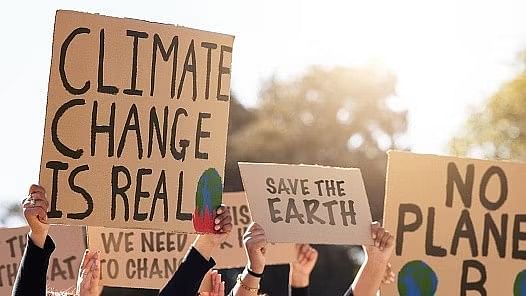
Representative image of climate change.
Credit: iStock Photo
In November 2023, the global temperature briefly exceeded 2 degrees C above pre-industrial levels, the upper limit set in the Paris Agreement in 2015. The world has witnessed rising carbon dioxide, temperature spikes, the loss of polar ice sheets, island inundation, and increased extreme weather events. While developed countries have historically contributed disproportionately to climate change, its impacts are borne widely by all nations. In India, Dalits, Adivasis, women, children, and the elderly are the worst hit. While the effects of climate change have primarily been observed at the environmental and societal levels, an unnoticed storm is brewing, impacting mental health—something we are unaware of and unprepared for.
Research indicates a deep connection between ecosystems and human health. Evolutionary biologists argue that we are unable to grapple with climate change because human brains evolved to react and respond to immediate threats. So while capitalism and overconsumption ensure human demands surpass the regenerative capability of the ecosystem, our cognitive biases prevent us from acting on its multifaceted impacts, such as pandemics, air pollution, and human migration. From a psychological perspective, this inability to comprehend the interconnectedness of the crisis prevents effective environmental or climate action.
The human brain remains an enigma. During the evolution of hominids, our cranial capacities tripled to house a larger brain. Ironically, evolutionary biologists argue that our palaeolithic brains are now severely challenged in the face of the rapid changes that modernity has wreaked over the last 200 years. This mismatch between our palaeolithic brains and contemporary challenges may contribute to prevalent mental health disorders. Some evolutionary psychiatrists say that mental health disorders persist because they are beneficial,
as they help conserve energy and slow down in challenging situations.
At the individual and family levels, climate change endangers children and teenagers, starting well before birth and affecting growth, cognition, and emotions. Heatwaves increase suicide risks among people. Direct mental health outcomes such as increased anxiety, depression, and post-traumatic stress disorder (PTSD) are expected to ensue with exposure to traumatic events such as wildfires and droughts. These may follow because of injuries and fatalities from disasters or a greater disease burden. The melting of permafrost exposes us to novel pathogens, some of which we have never experienced before.
At the community level, living with an increased disease load is not only physically debilitating but could also result in increased social isolation and feelings of humiliation. Indirect pathways through social, political, and economic mechanisms such as poverty, food insecurity, and unemployment exist. For coastal and island nations, first-hand experiences of extreme weather events cause fear, grief, and loss. It is alarming when psychologists must coin new terms such as ‘eco-anxiety’ and ‘climate grief’ to capture these ideas. Communities that witness the loss of home experience distress, a phenomenon called ‘solastalgia’.
Climate-induced distress influences couples to decide against having children. Such is the effect of environmental change on the family. A desire to not reproduce is antithetical to the survival of a species. While it may not be ‘civilizational suicide’ the desire to forego children says something about the unfavourable times we live in.
India is currently experiencing its demographic dividend, which means that the share of working-age adults is the highest in the population. Given the large number of young people entering education and the workforce, the impacts that climate change will have on lives, livelihoods, and health—both physical and psychological—are of a critical magnitude.
As the world convenes in Dubai for the 28th annual Conference of the Parties (CoP-28) to the United Nations Framework Convention on Climate Change to discuss the Loss and Damage Fund and to deliberate on health for the first time, we need to consider losses that go beyond the material and physical. The Loss and Damage Fund focuses on infrastructural and financial losses that countries face and miss out on the impacts on our well-being and mental health—deemed non-economic losses.
It is indeed challenging to quantify pain, suffering, despair, and a reduced quality of life. Governments can, however, measure direct healthcare costs (counselling, medication, and hospitalisation), productivity losses (number of workdays lost), and disability and welfare costs due to chronic mental health conditions (disability rates, duration of support required). There is a lack of sufficient engagement in key areas of intervention, mitigation, and cost estimation in this highly neglected sphere of our lives. The time for course correction is now.
(The writers teach at RV University, Bengaluru)